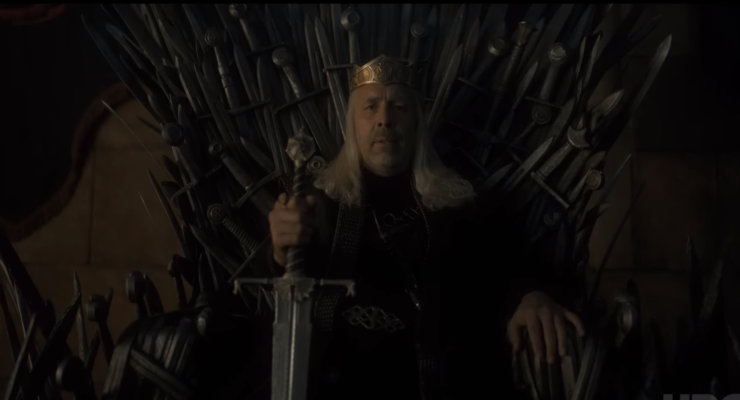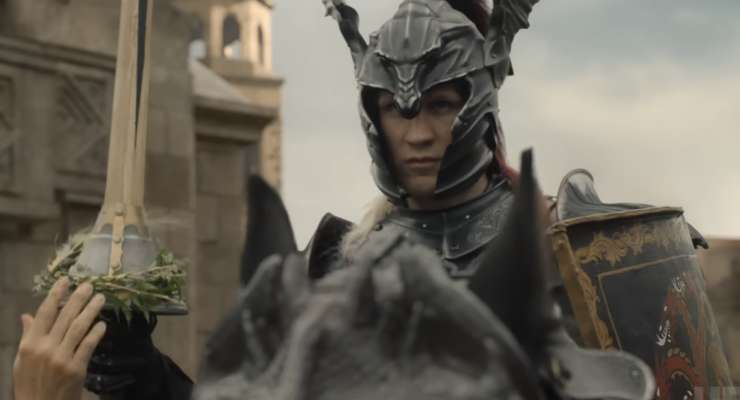I’ll admit that I enjoyed the original Game of Thrones series through to the end. In my 2019 reflection on the finale for this site, I even went so far as to say that I loved it, albeit with reservations. In the three years since, the series has become shorthand for opportunities missed, landings unstuck, and fanbase betrayed. While I find that assessment somewhat lacking in nuance, my excitement in anticipation of House of the Dragon has been commingled with apprehension: would the showrunners of this new series, Ryan Condal and Miguel Sapochnik, fix the mistakes made by Benioff and Weiss?
My immediate answer, having watched the inaugural episode, “Heirs of the Dragon,” is—maybe? It has all the hallmarks, for better and worse, of a Game of Thrones series: dynastic succession politics, exquisite sets and costumes, graphic violence, and an uncomfortable amount of nudity. People who despised the original series won’t be swayed by this one. Likewise, untroubled fans of OG Game of Thrones will find it to be similar enough to keep providing the same pleasures. For those of us that want to see an improvement on the original—a more diverse cast, better treatment of its female characters, and more pointed and restrained use of its penchant for sex and violence—there is reason for hope.
[Some minor spoilers/plot points are discussed below.]
On the first count, the show makes great use of Barbadian British actor, Steve Toussaint (Prince of Persia: The Sands of Time, Mutant Chronicles), as Corlys Velaryon. The original series mostly relegated Black actors to roles as slaves and exotic merchant princes, but Toussaint not only kills it as the calculating, quietly seething Lord Corlys, his casting implies that the ancient city state of Valyria was multi-ethnic. The Valyria of Martin’s novels has a slippery set of cultural signifiers. It’s vaguely an analog for the Roman Empire (which was far more ethnically diverse than it is typically represented), but it also stands in for myths of Atlantis and other highly advanced lost civilizations. It’s true that the Targaryens are depicted in Martin’s books as light skinned and having untextured white hair. But they also have distinctive purple eyes; that eye color—crucially cut from the show—is the sign of their otherworldliness, the inability to track them as analogs for any real-world group of people or, indeed, as fully human. By casting Toussaint as a Westerosi lord with Valyrian ancestry, the show is stepping away from the idea that the in-world ethnic group that is strangely beautiful, possibly super-human, and bent on subjugating the rest of the world is solely white.
On the second count we have a slightly more mixed bag. The original series got itself into a lot of trouble with its muddled handling of Daenerys Targaryen. She was used both as a thematic device for the toppling of patriarchal power and, ultimately as a figure for the tyranny of madness. That confusing approach to the character left a bad taste in my mouth as the show blundered into a story that could easily be interpreted as another lazy portrayal of a woman who was too emotional to wield temporal power. The source material for House of the Dragon has some interesting correctives for this, and the show is already starting to lay them out. Eve Best (The King’s Speech) does a terrific job of simultaneously lurking and looming in the background of the scenes she is in as Rhaenys Velaryon, a Targaryen heir passed over because of her gender and dubbed the “Queen that Never Was.” She’ll be a fascinating presence in a show that centers on the casual cruelty of agnatic primogeniture as seen through the eyes of two women in precarious positions of power.

On the other hand, the show’s depiction of the death of Queen Aemma (an Arryn in the book but, given her white locks in the show, perhaps retconned as a Targaryen) by non-consensual cesarean is a sequence that oversteps the bounds of good taste. Thematically, it fits rather neatly: the Queen’s breech pregnancy is destined to kill her, and her husband Viserys (Peaky Blinders and The Outsider’s Paddy Considine) is offered the choice of potentially saving their unborn child by sacrificing her. The graphic and disturbing sequence that follows does triple duty: presciently reminding its audience of the grotesqueries of denying women the right to choose, showing the audience that King Viserys, for all his equivocation and glad-handing, is a ruthless patriarch who chooses the indignities of power over the mercies of love, and setting up their daughter, Princess Rhaenyra’s desire to rule in her own right rather than be used as a disposable vessel for a King’s heir. All that said, it is a bit hard to tell how much the show wants that scene to be a powerful invective against the patriarchy and how much it delights in in exploiting cruelty for the shock value. The original series often wanted to have it both ways, to the profound detriment of the former.
One thing to be glad of in this new series is the fact that the show’s source material is fully finished. The series is based on Martin’s 2018 Fire & Blood–specifically on the second half of the text’s fictional history of the Targaryen dynasty–which itself is an expansion of his 2013 novella The Princess and the Queen, or, the Blacks and the Greens and his 2014 novelette, The Rogue Prince, or, a King’s Brother. The series offers a complete outline of this period of Westerosi history that feels epic in scope but also laser-focused on the Targaryens in such a way that it might avoid the original series’ penchant for dropping or too-quickly resolving plotlines and character arcs (especially evident in GoT’s later seasons.
I’m also looking forward to seeing the ways in which House of the Dragon makes concrete and definite what Martin merely adumbrates. The books this series draws from are consciously written as unreliable history texts. Martin’s narrator, Archmaester Gyldayn, discusses the numerous fictional source materials he had to consult in order to write his text—often offering two or three different accounts of the same event with the biases of their authors on full display. House of the Dragon will have to make decisions about what really happened in those numerous moments when Martin (as Archmaester Gyldayn) throws up his hands and says he simply isn’t sure what the truth is.
Already, the show is making bold and exciting choices about its characters that are either glossed over or entirely absent from Martin’s source material. The first episode centers on the friendship between Rhaenyra Targaryen (played in this episode by The Gloaming’s Milly Alcock) and Alicent Hightower (played in this episode by Wonder Woman’s Emily Carey) two characters whose relationship is central to the book but whose childhood friendship is not notable enough to be remarked upon. Similarly, the show chooses to reimagine Daemon Targaryen (the inimitable Matt Smith, further solidifying the trend of typecasting him as terrifying-monster-in-period-drama) as a smirking, crooked cop—illustrating his style of leadership with a sort of Medieval police riot.

In terms of its design, the inaugural episode chooses to return to some of the descriptions in Martin’s prose to bring more of the majesty and menace of Westeros to the screen. Especially lovely are two design choices: The first is the addition of other blades to the dais on which the Iron Throne sits. It brings it that much closer to Marc Simonetti’s iconic illustrations of the throne as a hulking, predatory bit of furniture. The second is a candlelit shrine holding the massive skull of Balerion, the Black Dread. Here, the skull is given the ferrous sheen that Martin describes as being unique to dragonbone and is sadly missing from the original series. These two changes are somewhat minor, but they show an interest in drawing out the Gothic details that make the source material such an unsettling delight.
Oh. Also. Dragons! Two of them! Very cool looking! Eight more have been promised in the show’s opening narration! I literally couldn’t sleep two nights ago because I couldn’t stop thinking about how gosh dang big Vhagar is going to be! These dragons are gonna be great!
Overall, the episode seems deliberately paced—slower than I’d anticipated and a welcome relief from the breakneck speed of the final couple seasons of the original series—well acted, visually sumptuous, and at least somewhat aware of the problematic legacy of its predecessor. I will be watching the next episodes with a little less dread, though not completely free of it.
Tyler Dean is a professor of Victorian Gothic Literature. He holds a doctorate from the University of California Irvine and teaches at a handful of Southern California colleges. He is one half of the Lincoln & Welles podcast available on itunes or through your favorite podcatcher. His fantastical bestiary can be found on Facebook at @presumptivebestiary.and his article “Exhuming M. Paul: Carmen Maria Machado and Creating Space for Pedagogical Discomfort” is forthcoming in Victorian Studies.










